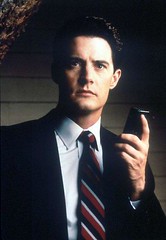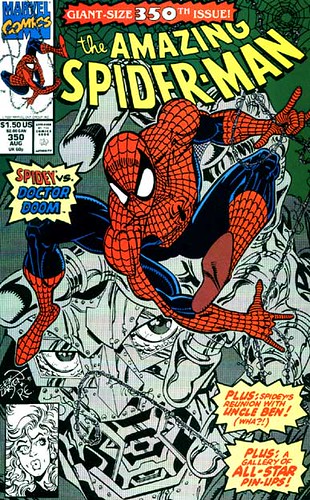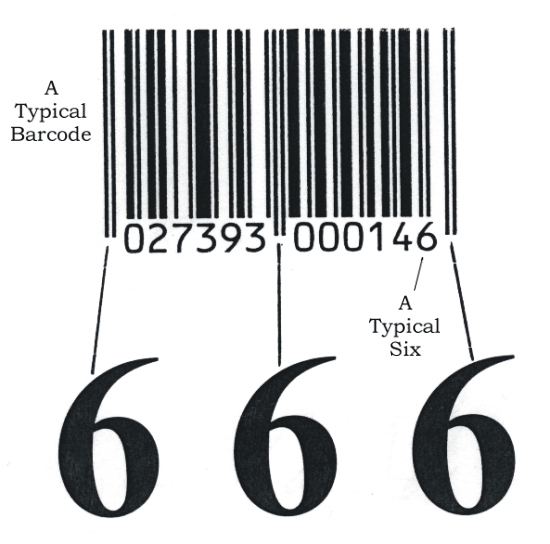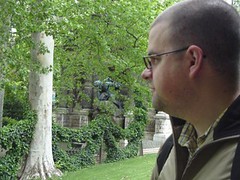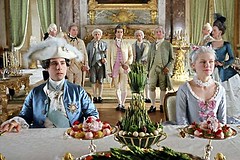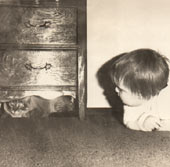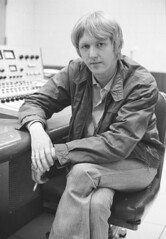 I just can't get interested in something--I have to get obsessed about it. That happened in a big way recently with Harry Nilsson. I knew little more about him than most other people did. I knew that he sang the song "Without You," which was a huge hit in the seventies. I knew that he had an album called Nilsson Schmilsson. I knew he was friends with John Lennon, that the two were drinking buddies during Lennon's "lost weekend," and that the two were once thrown out of a L.A. nightclub.
I just can't get interested in something--I have to get obsessed about it. That happened in a big way recently with Harry Nilsson. I knew little more about him than most other people did. I knew that he sang the song "Without You," which was a huge hit in the seventies. I knew that he had an album called Nilsson Schmilsson. I knew he was friends with John Lennon, that the two were drinking buddies during Lennon's "lost weekend," and that the two were once thrown out of a L.A. nightclub.
I keep a sort of mental checklist of artists that I want to look for whenever I go shopping for used vinyl. My memory is never the sturdiest of contraptions, so often times I remember not remembering a record I wanted to look for long after I have left the record store, vinyl in hand. Nilsson spent a long time on that list. My vague interest was renewed after getting obsessed with Chicago-based indie pop auteur Plush. I had listened to his album Underfed, then read about how that album consisted of demos for an album called Fed, which was recorded at an apparently extravagant expense and summarily released only in Japan. I snapped up his debut record, More You Becomes You, and then read Forced Exposure's review of it, which compared it to Nilsson Sings Newman. Curious, I started to read up on Nilsson, and my obsession started to grow.
I decided to start with the record I seen most often, Nilsson Schmilsson, and placed it firmly at the top of my mental list. But whenever I went vinyl shopping, I never saw it, or any Nilsson for that matter. There are some records that you just seem to stumble upon wherever you find used vinyl (Carole King's Tapestry springs to mind), but some that are harder to get.
I finally found it in Texas. We were visiting family in Austin, and doing a bit of shopping. We happened upon a record store whose front door was in an alley; there were signs leading to it all around the corner. When you entered, there was a huge room of vinyl. We didn't have a lot of time, yet I made the mistake of trying to be meticulous, searching record by record for interesting stuff. As Heidi started to get antsy, I fell back on my mental list, and Nilsson Schmilsson sprang immediately to mind. No luck in the Ns. I resorted to madly tearing through a bunch of records that were stacked in a sloppy, groove-crushing pile, just looking for something good to take away with me. And wouldn't you know, somewhere in that pile, I found Nilsson Schmilsson.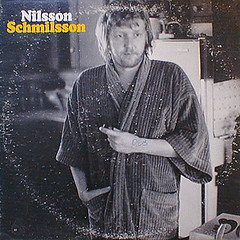 It would be appropriate for most people's purposes to say that Nilsson Schmilsson is the kind of starting-point record to recommend to curious listeners. It was his biggest seller, and contained his biggest single hit, "Without You," as well as "Coconut," which was recently resurrected for a Diet Coke commercial and was part of the Resevoir Dogs soundtrack, and "Jump Into the Fire," memorably used as the background music for Henry Hill's cocaine-fed meltdown in Martin Scorsese's GoodFellas. Yet this record defies what one would conventionally think of as a mainstream, accessible record. The title is zen-like and self-deprecating. The cover, shot by Dean Torrence of Jan and Dean, is comfortingly domestic but defiantly odd--Harry in his kitchen, wearing a bathrobe, looking like he needs a shower, smoking a hash pipe. The songs alternate from jaunty, Beatle-esque anthems ("Gotta Get Up," "Driving Along") to skeletal mind-teasers ("The Moonbeam Song," "Coconut," "I'll Never Leave You") to off-kilter barroom stomps ("Down," "Let the Good Times Roll"). The modus operandi on the whole is one of minimalism. Even the operatic "Without You" is built around a skeletal rhythm section, with Harry's vocal turn going from delicate to bombastic with balletic grace.
It would be appropriate for most people's purposes to say that Nilsson Schmilsson is the kind of starting-point record to recommend to curious listeners. It was his biggest seller, and contained his biggest single hit, "Without You," as well as "Coconut," which was recently resurrected for a Diet Coke commercial and was part of the Resevoir Dogs soundtrack, and "Jump Into the Fire," memorably used as the background music for Henry Hill's cocaine-fed meltdown in Martin Scorsese's GoodFellas. Yet this record defies what one would conventionally think of as a mainstream, accessible record. The title is zen-like and self-deprecating. The cover, shot by Dean Torrence of Jan and Dean, is comfortingly domestic but defiantly odd--Harry in his kitchen, wearing a bathrobe, looking like he needs a shower, smoking a hash pipe. The songs alternate from jaunty, Beatle-esque anthems ("Gotta Get Up," "Driving Along") to skeletal mind-teasers ("The Moonbeam Song," "Coconut," "I'll Never Leave You") to off-kilter barroom stomps ("Down," "Let the Good Times Roll"). The modus operandi on the whole is one of minimalism. Even the operatic "Without You" is built around a skeletal rhythm section, with Harry's vocal turn going from delicate to bombastic with balletic grace.
My Nilsson initiation set in motion, I proceeded to listen to Nilsson Schmilsson non-stop, and when I wasn't listening to it, I was thinking about it. Everything about Harry Nilsson, from his music to the man himself, seems manufactured to inspire either befuddled ennui or outright obsession.
Harry Nilsson spent a major part of the sixties trying to sell songs tin-pan-alley style in music business offices during his daytime hours, and spent his nighttime hours working as a bank clerk.
"Got a job at the bank. I took some tests, and I came out very high in the computer area. They were just starting computers. They said, 'Do you have any interest in computers?' I said, 'This is a dream come true. You bet!'Eventually his songs began to sell, and four of them were recorded by Phil Spector; two with the Ronettes, and one a duet between Nilsson and Cher. Soon he had what he called a “magical day” and experienced a creative breakthrough, writing three songs in one night: “Without Her,” “1941,” and “Don’t Leave Me.” Nilsson later recalled the creative surge, saying “…I realized then that I would never write another bad song.”2 “Without Her” was soon recorded by Glen Campbell, and has since been recorded by 13 different artists, including Blood, Sweat and Tears, George Benson, Herb Alpert and the Tijuana Brass, and Telly Savalas.
"So I got the job, kept the job. They found out I didn't graduate from high school and they called me in to fire me. I said, 'Look, I've done a good job. You know I have. I haven't been late,' and all that stuff. I cried tears and I said, 'Look, I had to do it, otherwise I wouldn't be able to get a job.'
"They really liked me, so they went out on a limb. They said, 'Okay, you're on probation for six months.' So I said, 'All right,' and I worked really hard for the six months, and they just kept me on and eventually I was in charge of the place when I left."1
Nilsson’s biggest breakthrough came rather unexpectedly.
The singer with the looks of a Swedish businessman…burst on to the scene at an Apple press conference in 1968. When asked who their favourite American artist was, the Beatles replied in unison "Nilsson!" And their favourite American group? "NILSSON!"One of the enduring traits of Nilsson’s career is that he was a songwriter’s songwriter—he wrote a number of songs that became hits for other groups (“One” for Three Dog Night, “Cuddly Toy” for the Monkees) while the biggest hits Nilsson recorded were written by other songwriters. “Everybody’s Talkin’”, written by Fred Neil, was the theme of the multiple-Oscar winning film Midnight Cowboy, a pop-culture landmark that helped make Nilsson a superstar and a Grammy winner for Best Contemporary Male Vocal Performance in 1969. Nilsson continued to feature other songwriter’s work throughout his recording career, eventually scoring another Grammy and another monster hit with Badfinger’s “Without You.” One of the cornerstones of his catalog is the 1970 album Nilsson Sings Newman, which featured songs by then-unknown L.A. songwriter Randy Newman, who accompanied Nilsson on piano. "He could do so many things as a vocalist that I couldn't do (like hold a note),"4 Newman said later.
They were enamoured of his debut album Pandemonium Shadow Show, a mix of vaudeville, classy orchestrated pop and the odd Beatles cover, delivered with Harry's sweet three-octave treatment.
The press were caught on the hop and hurriedly tried to get some info on this mysterious figure—they freaked when they discovered Nilsson had never even played live.
He told callers: "My amateur status is still intact, thank you."
The following Monday morning he received a phone call at 7am: "Is this Harry? This is John."
"John who?"
"John Lennon."
"Huh?"
"Your record is fucking fantastic, man. I just wanted to say you're great."
The next Monday at 7am Paul McCartney called him to rave in similar fashion about the album. Nilsson later recalled: "I got up the following Monday and waited for Ringo to call. He didn't."3
Nilsson’s early-seventies emergence as a recording superstar also saw him gain his reputation as a superstar party-animal. Two of his more notorious buddies were Keith Moon and John Lennon.
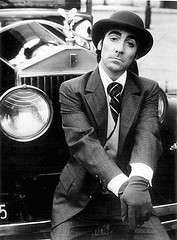 Nilsson met wild-man Who drummer Moon on the set of the film Son of Dracula.
Nilsson met wild-man Who drummer Moon on the set of the film Son of Dracula.We were supposed to be on the set at six, but it was nine before everybody was there. Then somebody brought out a bottle of brandy. Me, I think. Ah-Ha-Ha-HAHAHA! And Peter Frampton said no, no, too early, and some of the others said no. But 'Arry was standing there with an 'alf-pint mug. I knew at that moment it was destiny put us together. AhHhh-HAHAHAHAHA HAHAHA!
So we were drinking brandy at nine and, thanks to Mal Evans, white wine all the rest of the day. Then about six o'clock somebody came 'round and slipped little envelopes into our 'ands. It was a pay packet! I 'adn't 'ad a pay packet in ten years. And 'Arry'd never 'ad one. We were pretty well out of it, and we looked at each other and then tore up one-hundred and seventy pounds in one-pound notes, threw it up in the air and danced about, cackling like schoolboys. AHHHH-HAAAA-HAHAHA-AA-HAAAAHAAA-haaa! Dancing and leaping about, clutching bottles of Blue Nun liebfraumilch in our hands, singing, "We're millionaires, aren't we?"5
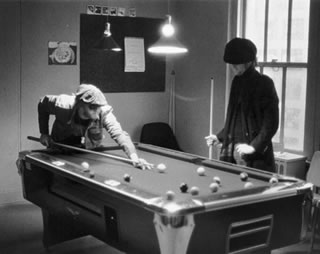 Nilsson’s connection with the Beatles retains a strong hold to this day; when discussing Nilsson, fans often reflect upon the Beatles era in general, and Nilsson’s friendship with Lennon in particular. Lennon played a major part in Nilsson’s monetary success, helping secure a 5 million dollar contract for Nilsson after the success of the “Schmilsson Cycle”: Nilsson Schmilsson, Son of Schmilsson, and A Little Touch of Schmilsson in the Night. Five million dollars was a then-unheard of amount for a recording artist.
Nilsson’s connection with the Beatles retains a strong hold to this day; when discussing Nilsson, fans often reflect upon the Beatles era in general, and Nilsson’s friendship with Lennon in particular. Lennon played a major part in Nilsson’s monetary success, helping secure a 5 million dollar contract for Nilsson after the success of the “Schmilsson Cycle”: Nilsson Schmilsson, Son of Schmilsson, and A Little Touch of Schmilsson in the Night. Five million dollars was a then-unheard of amount for a recording artist.“I had signed an agreement with RCA for a new, $5 million contract and they had reneged on it; the new president didn't sign it. I had been saying, "The contract's binding. We'll take you to fucking court, man.' And the president had said, 'It's not binding here….'
"I said to John, 'I just got $5 million, and they took it away from me, like that.' He said, 'Ah, they're all fuckers, Harry. They're all fuckers." He said, "Just go down and tell the guy he's a fucker.'
"So I went down to RCA. We'd been up all night long and it was now 10 in the morning. Both still drunk, with shades, hats, dark jackets. The secretary said, 'Mr. Glancy, uh, Harry Nilsson and John Lennon are here to see you, sir.'
"'What?' Boom! Door opens immediately. We walk in. There we are, you know? In every office, heads are turning to look at us. He said to John, 'Hi! How are you doing, sir? Would you like a cigar?' John said, 'No, thanks. I'd take a brandy.' So we had a brandy, and John said, 'Look, it's about Harry. You know, you've only ever had two artists on your label: Elvis and Harry. He told me what you're paying him. Look, for that money, I'll sign it. You've got an artist! Pay the two dollars!' 'Pay the two dollars' was like saying, 'pay the parking ticket, rather than fight City Hall….'
So he said, 'Well, we'll have to get the contracts together.' I said, 'No, no. They're on the 10th floor. They're in Legal. Ask Dick Etlinger, in Business Affairs. He's the guy.' So he calls up and says, 'Do you have the Nilsson contract? Could you bring it up here?' Because he didn't want to look like an asshole in front of John.
"They brought up the contract. I said, 'All you have to do is affix your signature where it says "President." Just write your name on it.' He said, 'Okay,' and he did it, right in front of John. John made me $5 million that minute. I looked at John for a minute and I almost cried. Then I said, 'I'd like four copies.' I gave one to John, one to me, one in the hotel safe, and I sent one out to California. And that's how I got to be a multimillionaire. Thank you very much, John!"6
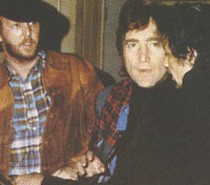 The most infamous and, sadly, enduring event of that period happened with Lennon at a performance by the Smothers Brothers at L.A.’s Troubadour nightclub. Albert Goldman recounted the events in his controversial book The Lives of John Lennon. At the time, Lennon was involved with an affair with his and Yoko Ono’s secretary, May Pang.
The most infamous and, sadly, enduring event of that period happened with Lennon at a performance by the Smothers Brothers at L.A.’s Troubadour nightclub. Albert Goldman recounted the events in his controversial book The Lives of John Lennon. At the time, Lennon was involved with an affair with his and Yoko Ono’s secretary, May Pang.About three weeks before the show, Yoko had called and told John that on her birthday she had slept with David Spinozza. (Spinozza, a well-known New York studio musician, later denied it.)The incident at the Troubadour marked a turning point in Nilsson’s life and career. Nilsson later lamented "that incident ruined my reputation for 10 years. Get one Beatle drunk and look what happens….It still haunts me. People think I'm an asshole and a mean guy. They still think I'm a rowdy bum from the '70s who happened to get drunk with John Lennon, that's all….I just introduced John and Ringo to Brandy Alexanders, that was my problem.”8 At a certain level the incident reminds one of the apocryphal story of Bob Dylan turning the Beatles on to marijuana circa-Rubber Soul, but on the other hand the fallout has a parallel with the still-potent ire directed at Yoko and Linda McCartney after the breakup of the Beatles. Apparently, Beatle fans are more willing to blame John and Paul’s wives for the breakup of their favorite band than they are willing to blame John and Paul themselves; similarly, they are quick to blame Harry Nilsson for John Lennon’s “Lost Weekend” dissolution, though it is hard to believe that Lennon had never discovered alcohol before he met Nilsson.
John appeared to be unaffected by the news. But Yoko's words set a time bomb ticking in John's madly jealous mind.
When he arrived at the Troubadour with May and Harry 'round about midnight on March 13, well before the second show, he was already half loaded and seething with anger. Ushered into the VIP section, where they found a celebrity clique, including Peter Lawford, Pam Grier, Jack Haley Jr. and Alan Sacks, producer of Welcome Back, Kotter,' the threesome booked their orders for triple milk shakes brandy Alexanders.
When the drinks arrived, John downed his in a single gulp. ''Let's have another round,'' he proposed expansively. Then he began to hum ''I Can't Stand the Rain,'' an ominous sign. Harry joined his voice with John's and soon both singers were performing happily, while accompanying themselves by banging spoons and knives against the glasses and saltcellars.
Having stolen the spotlight with their exhibitionistic behavior, Lennon and Nilsson were surrounded instantly by photographers. John Lennon had an instinctive talent for camera miming. When the spirit was upon him, he could shoot a look, a pose, a gesture into the lens that said it all.
Now he decided to send Yoko a little message, acknowledging the news of her birthday present. Grabbing May Pang by the throat, he pulled her toward him and planted a brutal kiss on her lips. As the flash cubes exploded, the photographers shouted, ''Who is she?''
John smiled at May and crowed, ''The secret is out!''
The Smothers Brothers were an object of liberal sympathy in Hollywood because of the way they had been booted off TV. This night was supposed to mark the beginning of their great comeback. The moment they stepped onstage, they received an ovation. But when the cheering and applause subsided, John and Harry could still be heard singing - louder than ever and without any sign of stopping.
Soon Lennon was alternating between loud singing and shouted obscenities. Occasionally, he'd vaunt: ''I'm John Lennon!'' Soon people all over the packed club were shouting back at John.
Finally, Ken Fritz, a mild little guy who managed the Smothers Brothers, came over to the table. He was hopping mad. ''Look,'' he shouted, ''we've worked hard for this, and I'm not going to let you fuck it up!'' With that, he grabbed John's shoulder.
John reared up instantly, overturning the table with a crash of shattering glass. Spinning around, he caught Fritz with a hook to the chin. Fritz swung at Lennon, as the crowd roared. Before either could throw another punch, Peter Lawford came charging in with a group of bartenders and waiters. Forming a flying wedge, they gave John and Harry the bum's rush. The hecklers were hustled through a furious crowd, whose members threw punch after punch at John Lennon.
In June 1974, John and Harry finished their whiskey-voiced album Pussy Cats. May Pang returned to Lennon's side in New York and Harry Nilsson left it forever.7
In a cruel twist of circumstance, Nilsson's deteriorating reputation and rock 'n roll history intertwined two more times; Mama 'Cass' Elliott of the Mamas and Papas and Keith Moon both died in Nilsson's London apartment, which he often loaned to friends while he was home in California, Elliott on July 27, 1974, and Moon on September 7, 1978.9
The cruelest twist in the Nilsson saga happened right before the sessions with Lennon for Pussy Cats. Nilsson ruptured a vocal cord, but as legend has it, hid the fact from Lennon out of fear he would end the sessions. Again, it is hard to believe that no one noticed the difference. The proof is in the mix--Nilsson's voice is ragged throughout the record, and hearing him try to reach the upper octaves he once scaled so effortlessly is nearly as painful to hear as it must have been to sing.
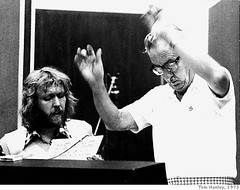 The common consensus is that Nilsson's non-stop partying lifestyle caused his vocal cord to rupture, but one could also blame the shift to the rock n' roll vocal style he adopted for Nilsson Schmilsson and exacerbated on Son of Schmilsson. He used to aim for subtlety, deftly creating a chorus with his multitracked three-octave voice, as best demonstrated on Nilsson Sings Newman, but in the Schmilsson cycle, for the first time in his career, he more often than not settled into a mid-range baritone yelp of the kind his buddy Lennon made famous on "Twist and Shout." While Son of Schmilsson's loopy contact-high makes it a quintessential "party record," it gains an unexpected and unintentionally melancholy pallor when one realizes the toll it must have taken on Nilsson's beautiful, signature voice, so triumphantly utilized on "Without You." Because of this, Nilsson's breezy-yet-sincere pop standards record A Little Touch of Schmilsson in the Night, perceived at the time as yet another bizzare indulgence, gains great significance, for it is the last time Nilsson's classic singing voice would be put to tape.
The common consensus is that Nilsson's non-stop partying lifestyle caused his vocal cord to rupture, but one could also blame the shift to the rock n' roll vocal style he adopted for Nilsson Schmilsson and exacerbated on Son of Schmilsson. He used to aim for subtlety, deftly creating a chorus with his multitracked three-octave voice, as best demonstrated on Nilsson Sings Newman, but in the Schmilsson cycle, for the first time in his career, he more often than not settled into a mid-range baritone yelp of the kind his buddy Lennon made famous on "Twist and Shout." While Son of Schmilsson's loopy contact-high makes it a quintessential "party record," it gains an unexpected and unintentionally melancholy pallor when one realizes the toll it must have taken on Nilsson's beautiful, signature voice, so triumphantly utilized on "Without You." Because of this, Nilsson's breezy-yet-sincere pop standards record A Little Touch of Schmilsson in the Night, perceived at the time as yet another bizzare indulgence, gains great significance, for it is the last time Nilsson's classic singing voice would be put to tape.The Nilsson catalog takes a hard right turn into obscurity after Pussy Cats, perhaps best personified by ...That's the Way it Is, which rock critic Stephen Thomas Erlewine memorably encapsulated by asking "for chrissakes, who wants this album?" The last "proper" Nilsson album, and his last for RCA, was 1977's Knnillssonn, which enjoyed a sincere marketing push from the record label until Elvis died, causing them to abandon Nilsson's record and put a full-court press effort into milking the King's back catalog.10
Nilsson was effectively retired from music for the rest of his life. His last widely-accessible musical effort came when he wrote the songs for the feature film adaptation of Popeye, with arrangements by Van Dyke Parks. Robert Altman said, "Nobody wanted him at first except Robin Williams. Everyone said 'You'll get in trouble with him -- he'll get drunk; he won't do it; he's all washed up.' As a matter of fact I said all of those things about Harry to Robin myself one day. Then I went home and thought about it and said to myself, 'Jesus, that's what some people are saying about me!' So I called Harry Nilsson, because I had never met him in my life, and we got along terrifically."11
 The rest of his time was spent trying to operate an independent production company he founded with counterculture icon Terry Southern called Hawkeye Entertainment. Their most notable output was the Whoopi Goldberg film The Telephone, which the two of them wrote. The movie was widely panned, which probably had no little part to do with Goldberg and her cinematographer husband suing the film's distributors to prevent them from releasing it, due to creative differences with the director, Rip Torn, who had never directed before, and has not since. Nilsson had to assume the reins of CEO of Hawkeye when the qualified man who had held the job was released. An L.A. Times story on Hawkeye's troubles took special care to describe Nilsson's deteriorating state:
The rest of his time was spent trying to operate an independent production company he founded with counterculture icon Terry Southern called Hawkeye Entertainment. Their most notable output was the Whoopi Goldberg film The Telephone, which the two of them wrote. The movie was widely panned, which probably had no little part to do with Goldberg and her cinematographer husband suing the film's distributors to prevent them from releasing it, due to creative differences with the director, Rip Torn, who had never directed before, and has not since. Nilsson had to assume the reins of CEO of Hawkeye when the qualified man who had held the job was released. An L.A. Times story on Hawkeye's troubles took special care to describe Nilsson's deteriorating state:His appearance has changed considerably from the way he looked on his album covers in the early 1970s, when he was a skinny young man with golden blond hair and beard. The hair and beard are graying, and his weight has ballooned to what he says is a lifetime high of 243 pounds.Out of the public eye, he spent the rest of his life as a husband and father with his wife, Una, and their six children, plus one grown son from an earlier relationship. This idyll was disturbed by three cruel strikes.
Always known as a heavy smoker and drinker, Nilsson does little to change that image. At a two-hour lunch last week, he nervously smoked half a pack of cigarettes and drank four vodka martinis, each with a twist of lemon.12
In 1991, he discovered that his manager, Cindy Sims, had been secretly embezzling his and other clients' money, going so far as to remove forclosure notices off of Nilsson's home to keep him unaware. In a letter filed in bankruptcy court, Nilsson wrote "We went to bed one night a financially secure family of eight and woke up the next morning with $300 in our checking account....I'm scared....I never believed this could happen. It was my greatest fear growing up and it's still my greatest fear."13
Nilsson would never see the outcome of his estate's travails in U.S. bankruptcy court. He suffered a heart attack on Valentine's Day, 1993. This spurred him into a flurry of activity, compiling a greatest hits collection for RCA, Personal Best, and beginning work on a new album with his new manager, David Spero. He even began work on an autobiography.
Sitting on a shelf above Spero's desk are several spiral-bound copies of a manuscript titled, "Harry's Book." The largest version contains pages and pages of color Xeroxes of old photos taken at Harry's Bel Air home: John Lennon stands in front of a pool table in combat boots and what appears to be a trench coat; he is without pants. Keith Moon mugs for the camera. Gene Wilder and Gilda Radner are captured in bed.Harry Nilsson died January 15, 1994, of a second heart attack. He was 52.
Spero says Nilsson spent a lot of time at Kinko's, making copies to put in his book or writing down random thoughts he remembered. There was one about the time "Harry and Keith Moon decided to stay sober (and failed hilariously)," another on "the real reason Harry and John Lennon were thrown out of the Troubadour when they went to see the Smothers Brothers."
"For two years, he'd call me every morning and told me stories. Sometimes they took three minutes, sometimes longer," Spero fondly recalls. Nilsson also sent cards and packages. When Spero's wife Ellen was seriously ill right after Nilsson got out of the hospital in '93, he sent a card saying, "What's left of my heart goes out to you."
Spero says Nilsson took quite seriously his doctor's warning that he might have only one to three years to live, but he would still eat three desserts if he felt like it, even with diabetes.
One day, Spero says he kiddingly asked Harry if he still had an old bathrobe he had almost worn out. "Harry said, `Of course, you never throw out old bathrobes.' A couple days later a Fed Ex box shows up with the bathrobe inside and photos of Harry in the yard in the robe,' says Spero, pulling out a color Xerox of Harry in his short blue bathrobe digging with a long-handled shovel. A handwritten caption across the bottom reads, "I Can Dig It."
The bathrobe now hangs next to the bathroom in Spero's office, an everyday reminder of Harry.14
Nearly all that remains of Nilsson is his extensive catalog, 18 albums strong, yet languishing for the most part in obscurity. He is the quintessential cult artist, known to few, yet obsessed over by his small, devoted fan base. In his heyday, he was as famous as his still-famous friends, but to this day his musical output is either marginalized in comparison to the songwriters he helped nurture and inspire, such as Randy Newman and Tom Waits. Those who give him any credit do so only on the merit of his two biggest singles, "Everybody's Talkin'" and "Without You." To this day he is most often remembered as the drinking buddy who got thrown out of a nightclub with John Lennon.
The sorry state of pop culture's memory of Harry Nilsson may be taking a turn for the better. Son of Schmilsson and A Little Touch of Schmilsson in the Night have been remastered and rereleased. A documentary film, Who is Harry Nilsson... (And Why is Everybody Talkin' About Him)? premiered at the Santa Barbara Film Festival to acclaim from Variety, the Hollywood Reporter, and Leonard Maltin, and recieved a standing ovation led by none other than Brian Wilson. Hopefully such efforts will renew people's interest in Nilsson.
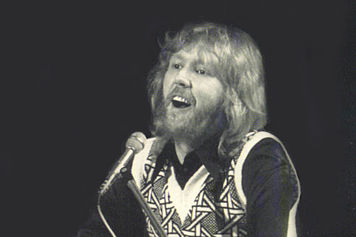 He was known as a singer's singer, a songwriter's songwriter, and the Beatles' favorite artist, and then he was forgotten. Ironically, the cornerstones of his artistic ouvre were a sincere nostalgia for the forgotten and marginalized elements of the American experience, and most poingnantly, an overwhelming fear of being left alone, abandoned and forgotten.
He was known as a singer's singer, a songwriter's songwriter, and the Beatles' favorite artist, and then he was forgotten. Ironically, the cornerstones of his artistic ouvre were a sincere nostalgia for the forgotten and marginalized elements of the American experience, and most poingnantly, an overwhelming fear of being left alone, abandoned and forgotten.Such is the cruelty of time, fate, and the fickle tastes of the fans of popular music. Harry Nilsson should never be forgotten. Lovers of popular music, to say nothing of the Rock and Roll Hall of Fame, should remember him and his music, always.
:::::
One thing I felt as I waded my way through the Nilsson discography was the need for a good compilation of his music. Personal Best seemed too large, and indeed, Nilsson intended it to be three CDs, not two. The newest greatest hits compliation Everybody's Talkin' is skimpy at 14 songs, and leans too heavily on Nilsson Schmilsson and Son of Schmilsson, ignoring almost all of his earlier catalog. Something had to be done.
This is what I came up with. My personal compilation of Harry Nilsson is called Me and My Arrow: A Little Mix of Schmilsson 1967-1977.
I tried my best to cover as much of his catalog as I could on a single disc, which was hard to do. I had to make a number of difficult omissions. There are no tracks from Son of Schmilsson, which I can hardly try to explain, other than to say "I tried." I tried so many times to fit the caustic "You're Breakin' My Heart" ("you're tearing it apart/so fuck you!"), but in the end decided it to leave it off, thinking that my mother would listen to it with my young niece in the car. (My mother made such considerations moot when she admitted being perplexed at receiving the CD, saying she was going to give it to my brother, who is also the father of my niece.) I also have no entries from Nilsson's catalog spanning between Pussy Cats and Knnillssonn, simply because I don't own any of those records. I would have liked to fit a song on there from Popeye, especially "He Needs Me," used to great effect in Punch Drunk Love, directed by L.A. auteur and avowed Nilsson fan Paul Thomas Anderson, but couldn't find it available for legal download anywhere before burning time.
So this is it, what I intended to be a definitive overview of the great Harry Nilsson songbook, knowing that such an endeavor is impossible. I'll get anyone a copy who wants one, and everyone else, and you know who you are, can construct their own. Those who are hooked are directed to pick up either Nilsson Schmilsson or Nilsson Sings Newman post haste, and after that, it's every Schmilssonian for his or herself.
1. Gotta Get Up (Nilsson Schmilsson, 1971). The first track of his iconic album is the first track of my mix, for reasons of sheer economy. A rousing, Beatle-esque number, which provides a funny counterpoint to the cover's image of a proudly lazy-looking Nilsson.
2. Vine St. (Nilsson Sings Newman, 1970). American pop music in a bottle; from a cod-boogie workout to a wistful rememberance of things past in a few minutes.
That's the takeThis song was nearly the first track of this compilation.
That we made,
But I'm sad to say we never made the grade.
That was me,
Third guitar,
I wonder where the others are.
3. 1941 (Pandemonium Shadow Show, 1967). An abstract work of autobiography, done up in baroque trappings. Surely something that "turned on" the Beatles, and struck an early chord of brotherhood in another abandoned son, John Lennon.
4. Daddy's Song (Aerial Ballet, 1968). Completes a doubleheader of missing-dad songs. Originally appeared on the Monkee's Head. Nilsson later recounted meeting the Monkees:
"So I sang seven, eight or nine songs, and Michael Nesmith said, 'Man, where the fuck did you come from? You just sat down there and blew our minds like that. We've been looking for songs, and you just sat down and played an album for us. Shit! Goddammit!' He threw something on the floor. And he went and got Mickey Dolenz and he said to him, 'Would you listen to this man? Listen to that!' Micky gave a surprised laugh, and Davy Jones started laughing over one song, and it was like the three of them were just out of their tree. Only Peter Tork couldn't give a shit."15This story is even funnier considering Nilsson once tried out to become a Monkee.
5. I Guess the Lord Must Be in New York City (Harry, 1969). The stylistic twin of "Everybody's Talkin'", this track was apparently offered first to the makers of Midnight Cowboy. One wonders if, had it been accepted, Harry would have won an Oscar rather than a Grammy.
6. One (Aerial Ballet, 1968). Nilsson the songwriter's most recognizable tune, in the skeletal form later lovingly recreated by Aimee Mann and Jon Brion.
7. Driving Along (Nilsson Schmilsson, 1971). The liner notes of this record's reissue report that Nilsson wished he hadn't included this song. I'm glad he did; it's one of my favorites.
8. Mournin' Glory Story (Harry, 1969). The most bizarre thing about this record may be how defiantly baroque and vaudville it is, being that it was released in the midst of the sixties' most turbulent and psychedelic year. This song has been on and off of this compilation more times than I can count.
9. Love Story (Nilsson Sings Newman, 1970). One of the most delicate vocal performances on a delicate album. This captures the mood of the record well; it wastes no time getting started, and lingers no longer than a millisecond at the end. In the middle of it all is a simple yet rousing chorus throwing the surrounding economy into stark relief:
You and me, you and me, you and me, baby,10. Early in the Morning (Nilsson Schmilsson, 1971). One of that record's quiet moments; makes me think I'm in Harry's living room some early morning in L.A.
You and me, you and me, you and me, baby,
You and me, you and me, you and me, baby,
You and me, you and me, you and me, baby
11. Me and My Arrow (The Point! 1970). Anthem from the animated program, written by Harry, about a boy and his dog. It sounds strangely funky, says a whole lot with very little, and barely lasts two minutes.
12. Jump into the Fire (Nilsson Schmilsson, 1971). The rockingest song from Harry's "rock album." His wail is unforgettable.
13. Everybody's Talkin' (Aerial Ballet, 1968). Strange thing is, it's hard to believe that this is Nilsson. For a guy that could do just about anything with his voice, this sounds the most different of anything he ever sang.
14. Without Her (Aerial Pandemonium Ballet, 1971). Harry cashes in and welds together his first two records, rerecording many of the vocals. But it's too late, he's already helped invent chamber pop. Nilsson made a career out of singing sad songs, and this is one of his most teasingly downbeat.
15. The Moonbeam Song (Nilsson Schmilsson, 1971). It is what it says it is, and it is one of the prettiest songs Nilsson ever put to wax.
16. All I Think About is You (Knnillssonn, 1977). The opening salvo of Nilsson's final proper album. His trademark circular lyrics are in full effect, but it is given a haunting poignancy by his latter-era husky baritone. It will give you chills if you let it.
17. Coconut (Nilsson Schmilsson, 1971). Shit is crazy.
18. The Beehive State (Nilsson Sings Newman, 1970). This record won Stereo Review's album of the year award, and it might be because of this song. What sounds like Nilsson's voice being run through a wah-wah pedal is actually Nilsson opening and closing the cups of his headphones in front of the microphone to the beat.
19. Cuddly Toy (Pandemonium Shadow Show, 1967). Another track made famous by the Monkees; Harry flashes his naughty, miscreant streak early on in his career. What do you think this means?
You're not only cuddly toy that was ever enjoyed by any boyMind you that the Monkees sang this.
You're not the only choo-choo train that was left out in the rain
The day after santa came
You're not the only cherry delight that was left out in the night
And gave up without a fight, ohhhh,
You're not the only cuddly toy that was ever enjoyed, ha, by any boy
You're not the kind of girl to tell your mother
The kind of company you keep
I never told you not to love no other
You must of dreamed it in your sleep, zop, zop,
20. Without You (Nilsson Schmilsson, 1971). Here it is, the song to end all songs, the tribute to codependence, the world's first power ballad. The key thing is to listen. Listen to this. This song is incredible. It sounds so delicate, just two piano chords, played almost half-disinterestedly, and then in comes Nilsson, crooning so softly you'd swear he was lying in bed next to you.
No I can't forget this evening....Then Jim Keltner tumbles in on the drums, slowly beating them as though he were lurching forward with all his might against gravity itself, and Klaus Voormann just follows him up the stairs on bass. Have I not mentioned Klaus Voormann yet? This guy was best friends with the Beatles in Hamburg, and very well could have been playing bass for them on the Ed Sullivan Show, but still ended up being on just about every ex-Beatle's first solo record, and here he is with Nilsson. You just can't take the Beatles out of Nilsson, nor Nilsson out of the Beatles.
Or your face as you were leaving
But I guess that's just the way the story goes
You always smile but in your eyes your sorrow shows,
Yes it shows.
No I can't forget tomorrow
When I think of all my sorrow
When I had you there but then I let you go
And now it's only fair that I should let you know
What you should know.....
Hearing Nilsson scale the heights of his dizzying vocal range never fails to thrill. This is, and always will remain, a song that only Harry Nilsson could sing. This fact makes the profound tragedy surrounding the song's writers, Pete Ham and Tommy Evans, only more tragic.
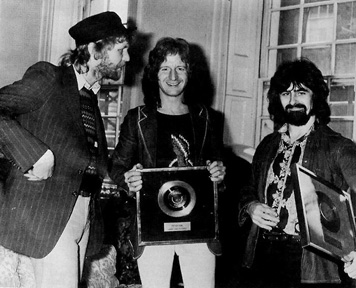 Nilsson heard this song at a party long before he recorded it, and thought it was a Beatles song, but later found out it was written by the Beatles' band of proteges, Badfinger. By the time Nilsson made it a smash hit, Badfinger had already been swindled out of the royalties to their songbook, and suffered due to the collapse of their label, the Beatles' Apple Records, and subsequent mistreatment by Warner Brothers records, which caused Wish You Were Here, which should have been a triumphant comeback, to wither unheard on record store shelves. When "Without You" was a hit, Ham was working menial labor in a factory just to make ends meet, his own song playing on the radio as he worked.16 Ham hung himself in 1975, and Evans did the same in 1983. Nilsson did a stand-up thing when "Without You" hit and presented both of them with silver records (right), but it ultimately did little to forestall the fates of these two doomed rockers.
Nilsson heard this song at a party long before he recorded it, and thought it was a Beatles song, but later found out it was written by the Beatles' band of proteges, Badfinger. By the time Nilsson made it a smash hit, Badfinger had already been swindled out of the royalties to their songbook, and suffered due to the collapse of their label, the Beatles' Apple Records, and subsequent mistreatment by Warner Brothers records, which caused Wish You Were Here, which should have been a triumphant comeback, to wither unheard on record store shelves. When "Without You" was a hit, Ham was working menial labor in a factory just to make ends meet, his own song playing on the radio as he worked.16 Ham hung himself in 1975, and Evans did the same in 1983. Nilsson did a stand-up thing when "Without You" hit and presented both of them with silver records (right), but it ultimately did little to forestall the fates of these two doomed rockers.21. Think About Your Troubles (The Point! 1970). Whew! Good time to just sit and think things over, like how a teardrop can fall into a teacup, then get thrown in the ocean, where somewhere a whale's body is decomposing, 'cause that's what happens to bodies at the bottom of the ocean....Ok, things are starting to gain perspective, until....
22. Don't Forget Me (Pussy Cats, 1974). By default, the most touching song on a gonzo album, made all the more heartbreaking by the broken voice that sings it. Marianne Faithfull, once famous for getting busted for drugs wearing only a throw rug in swinging London with her boyfriend Mick and his buddy Keef, revived the song as she tried to revive her own singing career in 1997. "'I wanted one of my own contemporaries on the record,' Faithfull says of the Nilsson selection. '(The song) had to be something that matched up to the other material. It needed wit, charm, and a real musicality as well . . . In the end, I couldn't find anything other than a Harry Nilsson song that would have fit.'"17 Depite her reverence for her late friend's work, she still found time to bizarrely slander the man and the circumstances of his death. "We used to do drugs together. When I say drugs, I don't mean those modern-day, airy-fairy drugs. I'm talking about narcotics. One day I had to stop because I was going to die. So I went off to this place in Minnesota--I highly recommend it."18 She also claimed that he died in a dentist's chair, and that while his body sat in the mortuary, it was swallowed by a fissure during an earthquake. "Harry's rather large body--I suppose it was all the drugs and alcohol--fell down a fissure and was lost forever. So they buried another coffin that they filled with stones."19
Dawn Eden, writer of the last and most definitive Harry Nilsson interview still available, One Last Touch of Schmilsson, refuted Faithfull's claims about Nilsson dying in a dentist's chair and disappearing through the Earth's crust. Yet a story told by Paul McCartney about a visit he made to Lennon and Nilsson during the Pussy Cats sessions attests to Faithfull's other claim:
"So I went out there and he was doing Pussy Cats with Nilsson and Keith Moon and Jesse Ed Davis, to name but three total nutters. Three beautiful total alcohol nutters plus John, forget it! Even the location is perfect. We went round to a session and sat there for a bit. It was a bit strange, John and I, seeing each other at that time. But then we dropped by their house the next day for a cup of tea or something.23. I'll Never Leave You Alone (Nilsson Schmilsson, 1971). Nilsson ends his touchstone album with a song that says "the album's over, but you'll never get rid of me." Indeed, this haunting coda makes such assurances true.
"I remember Harry Nilsson offering me some angel dust. I said, `What is it?' He said, `It's elephant tranquilliser.' I said, `Is it fun?' He thought for about half a minute. `No,' he said."20
24. Over the Rainbow (A Little Touch of Schmilsson in the Night, 1973). Ok, I could have cut this to make room for "You're Breakin' My Heart," but I'm a sucker for this song, and I'm trying hard to land this ship safely. Plus, hearing Harry recite his studio wish-list to the control room at the end is hilarious.
25. Living Without You (Nilsson Sings Newman, 1970). More supremely-wrought heartache from one of Nilsson's best efforts, this time providing a fitting end to a rememberance of a great man.
Ev'ry one's got something:::::
And they're out tryin' to get some more
They got something to get up for
Well I ain't about to.
Nothin's gonna happen
Nothin's gonna change
Baby, it's so hard
Living without you
It's so hard
Baby, it's so hard
Baby, it's so hard
Living without you
1. Eden, D. (1994). One last touch of Nilsson. Goldmine 20(9). Retrieved June 22, 2006, from http://www.harrynilsson.com/page-one-last-touch-of-nilsson-part-1.html
2. Eden.
3. Stanley, B. (2004, February 20). Hit & myth. The Times. Retrieved June 20, 2006, from Factiva database.
4. Wener, B. (2000, June 28). Something gained in translation: Harry Nilsson's lyricism, Randy Newman's lyrics a potent combination [Record review]. The Orange County Register, p. B08. Retrieved June 20, 2006, from Factiva database.
5. Hopkins, J. (1972, December 21). Keith Moon bites back [Electronic version]. Rolling Stone. Retrieved June 22, 2006, from Rolling Stone Web site: http://www.rollingstone.com/news/profile/story/9264343/keith_moon_bites_back
6. Eden.
7. Goldman, A. (1988, August 30). Yoko’s loss is Pang’s gain—briefly [Republished portion of the book The lives of John Lennon]. St. Louis Post Dispatch, p. 1D. Retrieved June 22, 2006, from Factiva database.
8. Eden.
9. Lewis, J. (2006, May 3). It happened here...No. 19 Curzon Place, Mayfair. Time Out London, p. 94. Retrieved June 22, 2006, from Factiva database.
10. Eden.
11. Altman, R. (n.d.). Popeye. Retrieved June 22, 2006 from http://www.harrynilsson.com/page-popeye.html
12. Bates, J. (1988, January 12). Nilsson's talkin': wealthy rock singer shifts attention to making movies; doubters wonder whether he can carry a business tune [Valley Edition]. Los Angeles Times (pre-1997 Fulltext), p. 9A. Retrieved June 20, 2006, from ABI Inform Global database.
13. Bates, J. (1994, November 7). In the end, only creditors talked to Nilsson. The Seattle Times, p. F5. Retrieved June 20, 2006, from Factiva database.
14. Barber, C. (1999, March 1). Memories of Harry: Songs by the late Harry Nilsson popped up in the movie "You've Got Mail" and rekindled interest in the singer-songwriter. The Cleveland Plain Dealer, p. 1E. Retrieved June 20, 2006, from Factiva database.
15. Eden.
16. Turner, R. (2004, December 18). Beatles guitar lands at auction after long and tragic journey. The Western Mail, p. 17. Retrieved June 20, 2006, from Factiva database.
17. Evans, M. (1997, March 21). Marianne Faithfull changes her tune. Portland Oregonian [Sunrise], p. 38. Retrieved June 20, 2006, from Factiva database.
18. Musto, M. (1997, February 11). La dolce Musto. The Village Voice, p. 10. Retrieved June 20, 2006, from Factiva database.
19. Pandora. (1999, June 16.) The Independent - London [Observational column], p. 4. Retrieved June 20, 2006, from Factiva database.
20. Miles, B. (1997, September 28). Yesterday, part 3: Without the Beatles, 'I didn't shave' [Republished portion of the book Paul McCartney: Many years from now]. The Observer. Retrieved June 23, 2006, from Factiva database.
:::::
My apologies to everyone I've bored in the wake of this obsession, and my sincere apologies to the people I've tried so hard not to plagiarize in making this. Please, everyone who reads this, read Dawn Eden's piece, buy Nilsson's records, subsrcibe to the L.A. Times, everything, do it. Maybe now I can just listen to some Nilsson sometime.

